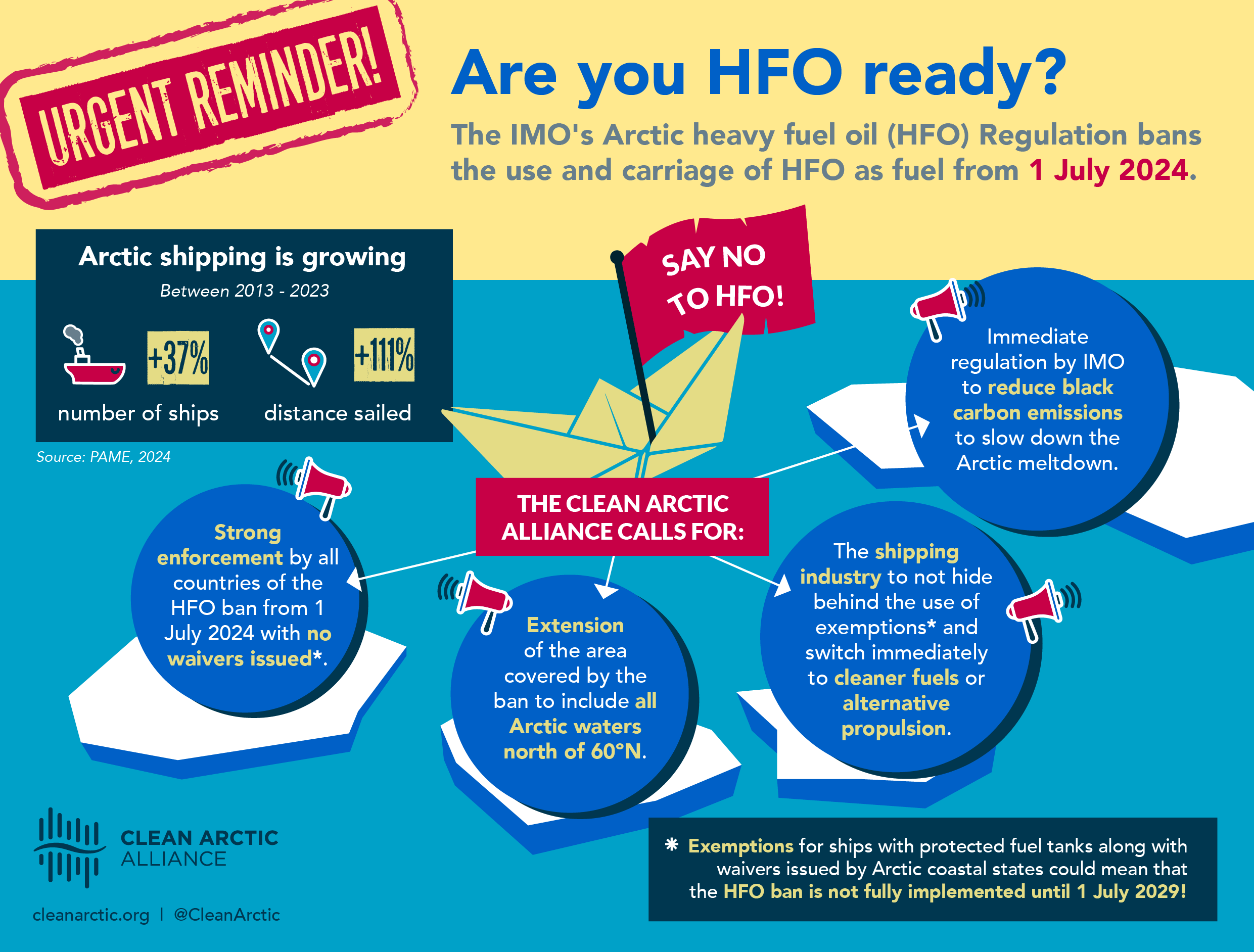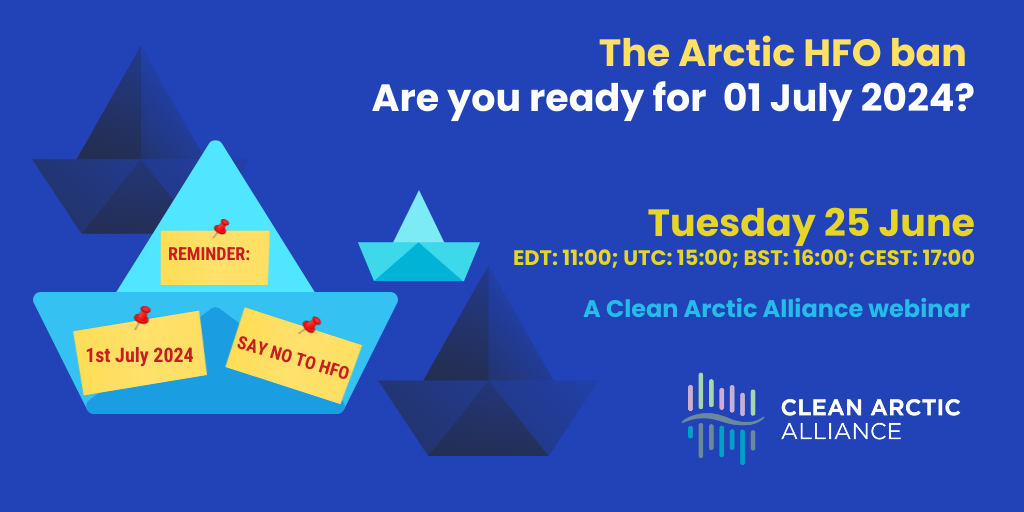
On July 1st, an International Maritime Organization (IMO) ban on the use and carriage of heavy fuel oil (HFO) by Arctic shipping will come into force. At first glance, this looks like great news indeed for the Arctic environment, and the people and wildlife who depend upon it.
Unfortunately, it’s not so simple. When the prohibition on use and carriage of polluting heavy fuel oil was agreed by the IMO in June 2021, it included significant loopholes allowing countries to grant waivers, and for shipping companies to make use of exemptions to the ban.
As a result, the ban will only come up to full speed in 2029. Until then, HFO will no longer be allowed to be used or carried for use while sailing in Arctic waters, unless a ship has a protected fuel tank or has been issued with a waiver by an Arctic coastal nation – meaning that potentially around 74% of Arctic shipping will remain unaffected by the ban. Yet Arctic shipping is growing. Recent Arctic Council studies of ship activity in the Arctic have shown an increase of 37 percent between 2013 and 2023 and a 111 percent increase in total distance travelled over the same time period.
Recently, an Irish vessel, the Arklow Wind, was fined by authorities in Svalbard for carrying heavy fuel oil. In Norwegian waters around the island archipelago of Svalbard the use and carriage of HFO has been banned since 2022, it has been forbidden to carry or use heavy fuel oil in territorial waters around the Arctic archipelago.
The ban, in its current form, leaves the Arctic marine environment exposed to the risk of devastating spills of HFO, and to emissions of black carbon. The International Maritime Organization has already formally recognised that black carbon is the second largest source of ship climate warming, and it is responsible for around 20% of shipping’s climate impact (on a 20 year basis). Black carbon has a disproportionately high impact when released in and near the Arctic – when emitted from the exhausts of ships burning oil-based fuel and settles onto snow and ice, it accelerates melting and the loss of reflectivity – the albedo effect – which creates a feedback loop that further exacerbates local and global heating.
With the Earth already plunged into a climate crisis, and with the potential for rapid Arctic changes to prompt disruption to the polar jet stream and the Gulf Stream, it is not enough for the shipping community to do the bare minimum.
This is why the Clean Arctic Alliance is calling on IMO member states, particularly Arctic coastal countries, to implement the Arctic HFO ban and enforce it fully with immediate effect – without resorting to loopholes. By doing so, the IMO can significantly reduce the risk of HFO spills and also see co-benefits – reducing air pollution, and slowing down the impacts of climate warming on the Arctic.
IMO Member States, especially Arctic coastal countries, must go farther than the IMO ban by implementing it in ways that truly protect the Arctic from HFO spills and black carbon emissions – and that means refusing to offer loopholes to ship operators.
The shipping industry can seize upon July 1st as a landmark opportunity to demonstrate its willingness to embrace a cleaner future; instead of hiding behind the use of exemptions, shipping companies can instead switch to readily available, relatively cleaner fuels such as diesel or distillate marine fuels, or to alternative forms of propulsion while installing diesel particulate filters. This would not only set an example for other industry players, it would demonstrate that the shipping world is willing and ready to go above and beyond the call of duty and to move towards eventual decarbonisation.
Combining better fuel choices today with the use of existing technology, ships operating in the Arctic would see black carbon or soot (a component of particulate matter) emissions reductions of more than 90%. As black carbon remains in the atmosphere for only a short period of time, if all shipping in the Arctic used lighter distillate fuels and installed diesel particulate filters – existing technology long used in land transport to reduce diesel fuel emissions – we would see rapid removal of a massive threat to Arctic sea ice – which is crucial for balancing the climate and weather in the Arctic and further afield.”
The use of scrubbers, however, must be avoided – they are an excuse to keep using HFO, while transferring air pollution into marine pollution and moving to gas fossil fuels such as LNG simply replaces one potent short-lived but high impact climate pollutant – black carbon – with another – methane. Use of diesel fuel along with the installation of particulate filters or precipitators, as prescribed for other forms of transport, can reduce emissions of black carbon by more than 90 percent quickly and be a solid first step on route to decarbonisation.
Dr Sian Prior is Lead Advisor to the Clean Arctic Alliance. Made up of 23 not-for-profit organisations, the Clean Arctic Alliance campaigns to persuade governments to take action to protect the Arctic, its wildlife and its people https://cleanarctic.org
- Briefing:
- Webinar:
- Press releases:
- Opinion articles:
- High North News, Opinion: Shipping Industry Must Seize Opportunity Posed by Arctic Heavy Fuel Oil Ban
- The Hill Times: Heavy fuel oil ban coming July 1, Inuit Nunangat communities still vulnerable to marine spills
- Alaska Beacon: Arctic meltdown continues as heavy fuel oil ban begins
- WWF: Despite heavy fuel oil ban, Arctic marine biodiversity still threatened
- Things to do
- Infographic
Webinar: The Arctic HFO Ban: Are you Ready for 1 July 2024?
Infographic: Are You HFO Ready?



